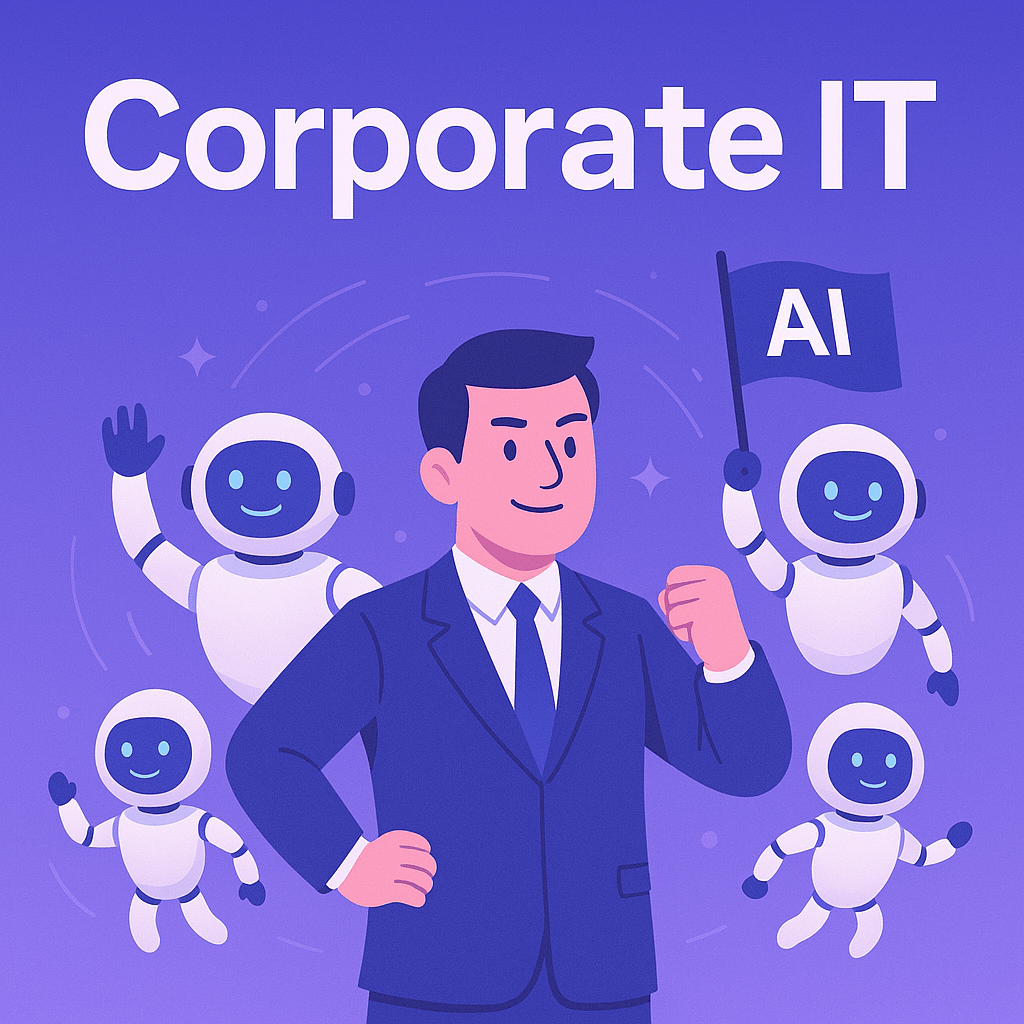For the last decade, corporate IT has been seen as… well, kind of boring.
Don’t get me wrong — it’s been essential. But somewhere along the journey from on-prem servers to cloud everything, the role of IT shifted from building to managing. Instead of crafting custom tools or writing code, IT teams became masters of procurement, access control, compliance, onboarding, and stitching SaaS together with duct tape.
But something big is happening.
AI is giving IT its swagger back.
We’re on the brink of a massive shift in how IT operates, how it delivers value, and how it’s perceived inside companies. This isn’t just another tech upgrade — it’s a redefinition of what IT even is.
Let’s talk about it.
A Quick History: The 3 Phases of Corporate IT
To understand where we’re going, let’s first revisit where we’ve been.
IT 1.0 — The Infrastructure Era
This was the golden age of server rooms, routers, Active Directory, and VPNs that mysteriously broke right before big meetings. IT held all the power. Want access to a database? Set up a dev environment? Too bad. Submit a ticket.
They built custom applications, managed deployments, and owned every layer of the tech stack — from the cables in the walls to the CRM on your desktop.
IT 2.0 — The SaaS/Cloud/IaaS Era
Then the cloud happened.
Suddenly, tools like Salesforce, Slack, Notion, and AWS exploded. Engineering teams started deploying infrastructure with Terraform scripts. Line-of-business teams started buying their own tools. Hardware and datacenters went from in-house to hyperscalers.
And just like that, IT became the middleware — provisioning accounts, managing identity, setting up integrations, maintaining security policies.
They didn’t build anymore — they managed.
And while that was efficient, it also sidelined IT from innovation. The real “building” moved to product and engineering.
IT 3.0 — The AI Era (That’s Now)
Now, we’re entering something new — and very different.
AI isn’t just making developers more productive. It’s giving non-developers the ability to build.
And that includes IT.
With tools like Replit Ghostwriter, GPT-4, Claude, and low-code/no-code platforms, IT teams are becoming builders again. But this time, they’re building faster, leaner, and more surgically.
Not monolithic apps, but small internal tools.
Not long dev cycles, but AI-generated workflows.
Not just managing users — but managing agents that do work on behalf of users.
This is the rebirth of IT as an internal innovation engine.
The Return of the Builder Mindset in IT
Here’s what’s already starting to happen in modern IT teams:
- Sales needs a way to auto-route leads to regional teams.
IT spins up an Airtable + Zapier + OpenAI workflow that does it in 24 hours. - Customer success wants to generate personalized summaries for each onboarding call.
IT wraps the meeting recording pipeline with Whisper + GPT and delivers an internal chatbot. - Legal asks for a contract review assistant.
IT integrates Claude with the company’s document repository and fine-tunes prompts.
Just a few years ago, all of this would have required cross-functional alignment, sprint planning, design reviews, and QA cycles.
Now? IT can ship these microtools — often without writing a line of traditional code.
And this is just the beginning.
From Apps to Agents: What’s Next for IT
One of the most exciting parts of this evolution is where it’s headed.
We’re moving beyond internal tools — and into agent-based systems.
Imagine an IT team deploying agents that:
- Auto-triage support tickets based on context and past resolutions
- Monitor security anomalies and take immediate action
- Act as co-pilots for employees, summarizing dashboards and answering routine queries
- Pull data from across cloud platforms and generate daily decision briefs for execs
These aren’t science fiction. They’re already being prototyped inside progressive orgs.
And guess what? Managing these agents — designing them, training them, monitoring them — is going to fall squarely under IT.
AgentOps might just be the next big IT function.
So What Does This All Mean?
Let me bottom-line it for you.
Corporate IT is evolving — again. But this time, it’s not about managing hardware or licensing software.
It’s about becoming builders, orchestrators, and agent managers.
And that means:
- More creativity inside IT
- More value delivered to business teams
- Faster innovation cycles
- And a complete rethinking of what “internal tooling” means
If you’re in IT: this is your comeback story.
If you’re building for IT: this is your chance to create tools that empower the next wave of builders.
And if you’re in SaaS: you’re no longer competing on features — you’re competing on why not just build it ourselves?
TLDR
We’ve seen IT evolve from running cables to running SaaS.
Now we’re about to watch it run internal software, agents, and entire AI ecosystems.
Not because they have to — but because now, they can.
The next decade of IT won’t be passive. It’ll be creative, experimental, and fast.
And I’m here for it.
